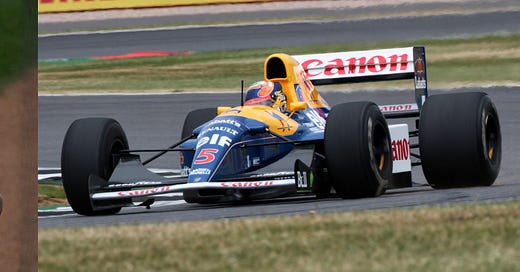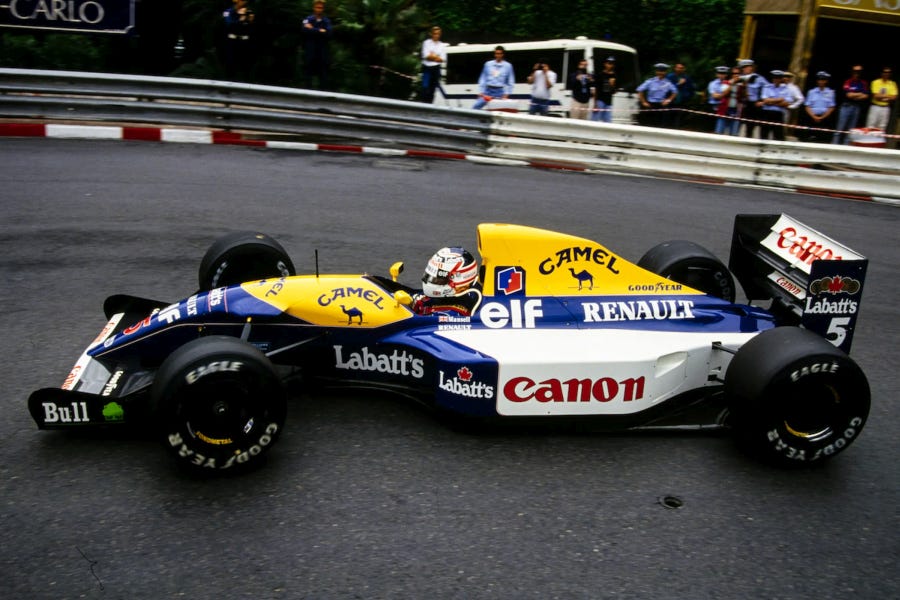The Yankees’ Torpedo Bats Are a Formula 1 Moment in MLB
What happens when a sport is totally blindsided by (legal) technological innovation?
Coming out of the opening weekend of the 2025 season, the baseball world is abuzz over one thing and one thing only: the New York Yankees’ new bats.
Using a design nicknamed the “torpedo”, with a barrel that tapers at the end and concentrates more mass around the zone where ball contact is likely, a number of the Yankees’ hitters contributed to an offensive barrage that included 20 runs against the Brewers on Saturday and 12 more on Sunday. They also tied an AL/NL record for the most home runs (15!) in a team’s first three games of a season. And on the season overall, they’re scoring 12 runs per game with a 1.231 OPS. While not every Yankee is using a torpedo bat — notably, Aaron Judge is sticking with his usual setup — those who are (i.e., Anthony Volpe, Cody Bellinger, Jazz Chisholm Jr.) seem to be enjoying the new equipment to start the year.1
Naturally, the mind goes to a few different places after seeing the Yankees’ onslaught with their new bats. Are those legal?? (Yes — there is no violation of Rule 3.02, which dictates the dimensions of the bat.) Who came up with this? (The credit appears to belong to former Yankees hitting analyst Aaron Leanhardt, who is now with the Marlins.) Will other teams be clamoring to use them? (Almost certainly yes; as Manny Machado joked on Sunday, “They should send a few over here if they’re going to be hitting homers like that.”)
But as I learned about the torpedo bats, my brain also went to another sport entirely: Formula 1.
There is a long history in auto racing of teams debuting radical technological innovations that catch the rest of the grid off-guard. That’s particularly true in F1, where huge staffs of well-funded engineers spend countless hours designing and testing new versions of their chassis every offseason, putting them through their paces in computer simulations and wind tunnel analyses. Usually, the result is merely gradual change. But sometimes, a new car hits the track and is unlike anything the sport has seen before.
Take, for instance, the Lotus 79, pictured above. Designed by a team headed by legendary Lotus founder Colin Chapman, this car was the first to truly exploit “ground effect” aerodynamics to create downforce, allowing the car to maintain grip at high speeds. (Think of how an airplane wing enables flight, but flip it around so that the pressure differences are pushing the car downward onto the track.) After debuting it in practice only at Monaco early in the 1978 season, Mario Andretti drove the Lotus 79 to victory in its first official race at Belgium, then again the following week in Spain. All told, the Lotus 79 was a total revelation — it won six of the first eight races it ran,2 powered a World Championship double for Lotus and Andretti, and ushered in a new aerodynamic era for the sport.
Interestingly, one of the only races during that stretch not won by the Lotus 79 was the 1978 Swedish G.P. — won by a car so insane, so innovative, and so potentially threatening to the sport that it was banned after a single race. That car was the Brabham BT46B, better known as the “Fan Car” because it used a literal fan to suck the car onto the track for maximum downforce. After Niki Lauda used it to win in Sweden by 34 seconds over the rest of the field, causing a stir of confusion and copycats not unlike the Yankees’ torpedo bats, the FIA swiftly decided that fan cars would never be allowed again in F1. Thus, the BT46B was “won-and-done”, retiring with a perfect 100% winning percentage.
Fast-forward to 1992, and the F1 world was caught napping once again — this time by Williams and its FW14B car. The original FW14 had already been highly successful in 1991, helping teammates Nigel Mansell and Riccardo Patrese finish second in the Constructors’ standings behind McLaren with Ayrton Senna and Gerhard Berger. But the 1992 version, dreamt up once again by the GOAT of all F1 car-designers, Adrian Newey, took things to a level never seen before with the introduction of so-called “active suspension”, which helped the car achieve peak downforce in corners without losing speed. Paired with the aggressive Mansell behind the wheel, the FW14B completely dominated the 1992 season, winning eight of the first 10 races it entered en route to championships for both Williams and Mansell.
A year later, active suspension (and similar electronic driver aids) were banned from F1, never to return again.
And for one other final example, let’s zoom in on the only year of competition for Brawn GP, which rose from the ashes of Honda F1 to enjoy one of the most dominant single-season rides in racing history in 2009. Brawn was powered by a great deal of talent, from its namesake owner/director Ross Brawn (former Benetton and Ferrari championship team leader) to veteran drivers Jenson Button and Rubens Barrichello, the years of Honda R&D that led up to the ‘09 season and the Mercedes-Benz power units under the hood. But the BGP 001’s secret weapon may have been its “double diffuser”, which exploited a loophole in the rules to produce a massive increase in — you guessed it — rear downforce.
After legal challenges by rivals were shot down in court, the diffuser design was allowed to proceed — and the results spoke for themselves. Button won six of the season’s first seven races and Barrichello won two of the last seven to secure Brawn a World Constructor’s Championship in its only season of existence, with Button winning the drivers’ crown as well.
I could have included other examples from F1, including the 1976 Tyrrell P34 “six-wheeler”,3 or from other sports, but you get the idea. Sometimes these technical innovations made such an instant splash that the sport had to convene and decide whether to ban them; sometimes they were allowed to stand for a season but no more. And sometimes they simply became the new industry standard going forward. For now, the Yankees’ torpedo bats are legal — and they may be coming to a clubhouse near you soon, as a testament to the role that radical new design ideas play in the evolution of sports.
Granted, it is worth noting amidst all the breathless coverage that the Yankees were held to a more normal 4 runs in their first game of the year.
Up to the 1978 Italian Grand Prix, which saw the death of Andretti’s Lotus teammate Ronnie Peterson. (Yes, this was a fate all too common for great drivers of that era.)
Which was exactly what it sounds like.









